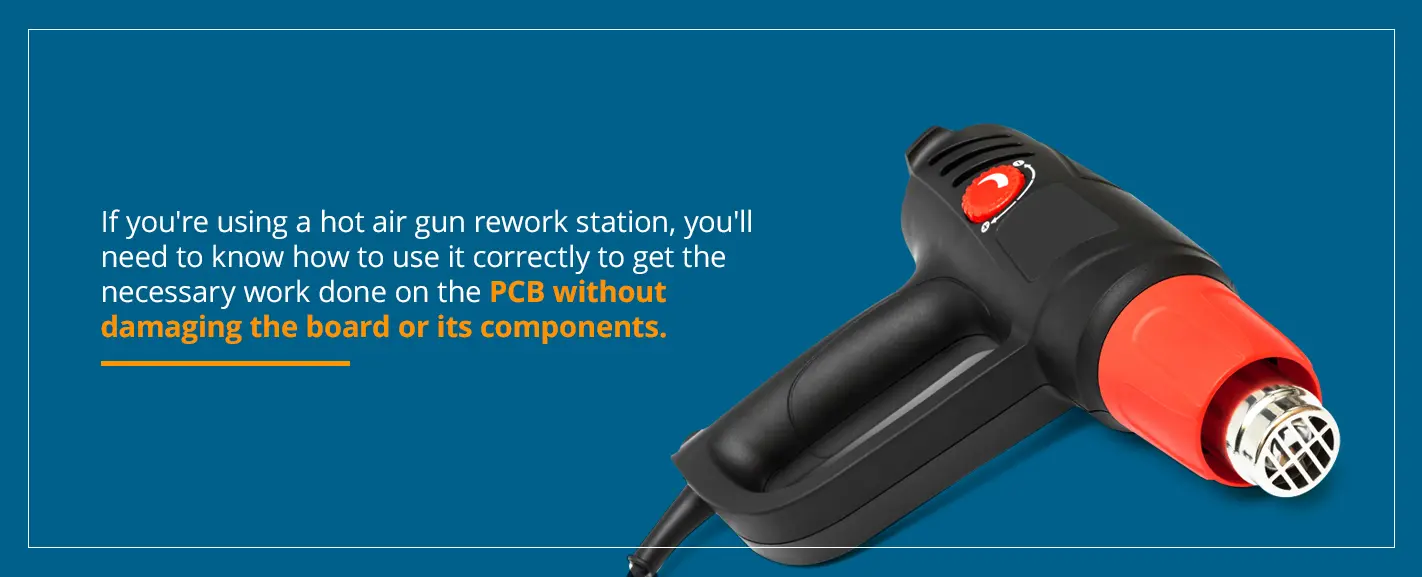Hot Air Rework Station vs. Heat Gun
Depending on your applications and budget, you might be wondering about the right approach to take when working on printed circuit boards, or PCBs. When it comes to the technology involved in heating up solder paste and installing or replacing electronic components, there’s an ongoing debate surrounding which type of rework equipment to use.
Much of this debate comes down to whether to use a hot air rework station or a heat gun. Let’s take a look at the advantages and disadvantages involved in each method, so you can determine the best choice for your needs.
Hot Air Rework Stations — Pros and Cons
As its name implies, a hot air rework station uses heated air — directed by varying sizes of nozzles — to evenly and quickly heat the PCB area you’ll be working on. Typically, a pump activates to circulate fresh air over a heating coil. Depending on which type of rework station you use, the pump’s action can produce noise that some operators find distracting. However, since you can precisely direct a rework station’s nozzle to the area you’re working on, the heated airflow occurs rapidly — so you can complete your work efficiently.
Another benefit of using hot air rework stations is that they can double as soldering stations as well. With a hot air station, you can remove broken or old components and — after thoroughly cleaning and prepping the area — use the same station to solder new pieces onto the existing PCB. Also, since most hot air stations operate on a non-contact method, you’re far more likely to avoid damaging other areas of the circuit.
Hot Air Guns — Pros and Cons
Some hobbyists note that an alternative to hot air rework stations is hot air guns — often made exclusively for embossing jobs. Hot air guns produce heated airflow that can melt solder and remove components — like ICs — from PCBs. The most significant advantage of these hot air guns is their low cost. Hot air guns are available for a fraction of the price of a professional hot air rework station. But if you’re serious about working on PCBs, this is where the advantages of hot air guns end.
Because hot air guns heat a large portion of any PCB you’re working on, they can also cause significant damage to other components, as well as the board’s laminate. And because hot air guns aren’t as accurate as rework stations, your resulting work area can wind up being pretty messy.

How to Use a Hot Air Gun
If you're using a hot air gun rework station, you'll need to know how to use it correctly to get the necessary work done on the PCB without damaging the board or its components. Let's talk a little about using this tool and explore some tips for reworking circuit boards with a heat gun.
To perform PCB rework with a heat gun, direct the heat toward the area you need to alter. Some heat guns' design allows them to sit on a bench without support. In that case, you can set the heat gun up to point at the correct area and then go about additional work with your hands.
You'll need to remember several safety tips to avoid injury and PCB damage as you use the heat gun station:
- Wear eye protection while working.
- Use a silicone mat to protect your table or workbench from heat damage.
- Never operate a heat gun near flammable or combustible materials.
- Never operate a heat gun with the nozzle fully pressed into the workpiece surface. Positioning the heat gun in this way restricts airflow, so the heat gun has a greater chance of overheating, which can cause fires and pose injury risks.
- Keep the air inlet grilles free from obstructions. If you cover or obstruct the inlet grilles, the heat gun may overheat and catch fire.
- Because heat guns draw so much power, try to use them with an extension cord only when necessary. Only use cords with the correct amperage rating, and always unwind the cord completely before use.
- Refrain from placing the heat gun nozzle next to any other object while it is hot.
- Never allow the heat gun nozzle to come near clothing or skin.
- Refrain from looking down the nozzle when the heat gun is on. Doing so could harm your eyes.
- Do not insert foreign objects into the nozzle of the heat gun.
- Turn the heat gun off before resting it on any surface.
- Allow the heat gun to cool before putting it away.
Uses for a Heat Gun
What are some common uses for a heat gun in PCB manufacturing and rework? You will most often use a heat gun for tasks like these:
- Desoldering components for various rework purposes
- Installing new electronic components
- Removing defective components
- Repositioning tombstone components
- Reworking cold joints
- Reflowing solder paste
- Removing solder bridging
- Securing wire connections with heat-shrinking
- Salvaging components from old boards
Whatever work a PCB may need, using a heat gun offers a cost-effective method for getting the job done right. Alternatively, if you need more precision to avoid board damage, you'll likely want to turn to a hot air rework station instead.
Contact Precision PCB Services, Inc. Today
For beginners and others just beginning to practice their PCB skills, a hot air gun can help start the journey to being more proficient at circuitry rework. But for anyone who’s serious about improving their technical skills or performing intricate work on expensive equipment, there’s no comparison.
For more information on hot air rework stations, as well as our training for their competent use, feel free to contact us today.